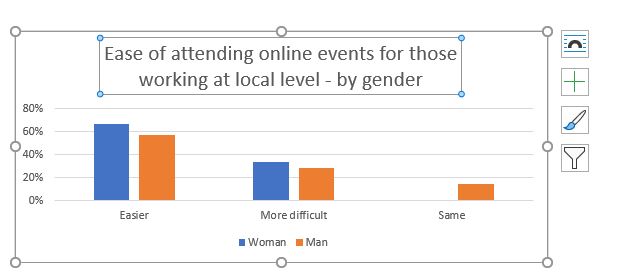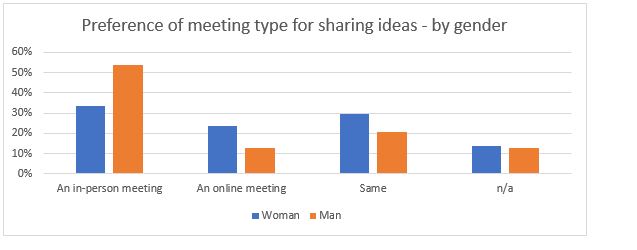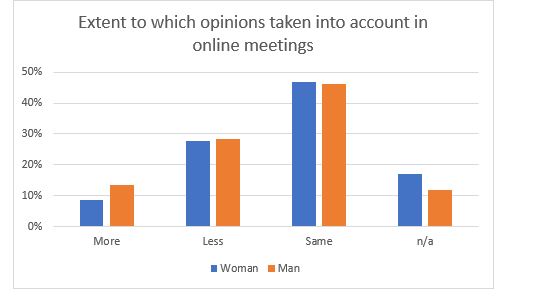Background
COVID-19 is affecting us all in almost every facet of our lives. Many forest conservation and REDD+-related engagement efforts and events have been reorganised as virtual meetings or webinars. The UN-REDD Programme undertook a brief survey to explore the effect of this new normal on the participation of women and men in forest conservation and REDD+, as well as to identify ways to further promote the equitable and active participation of women and men.
Results
In total, 119 people completed the survey (67 men, 47 women and 5 people who preferred not to disclose their gender). Of those respondents, 36%, 40% and 24% primarily work at the global, national or local level respectively.
-
20% were between 18 - 35 years old, 53% between the ages of 36 - 55 and 29% were 55 years or older
-
23% of respondents worked for national governments, 18% for civil society organizations (CSOs), 15% for private sector, 13% for academia, 9% for international partners or donors, 4% were indigenous people or forest communities and 2% for financial institutions
Ease of Attendance
When asked whether the virtual format of meetings during COVID made it easier, the same or more difficult for respondents to attend, 55% of women and 57% of men found it easier, while 17% of women and 24% of men found it more difficult.
When this data is further broken down by affiliation, 53% of male and 56% of female national government staff found it easier, while 29% and 22% respectively found it harder. As one female national government representative noted, the flexible hours of the online format helped, “since we (women) are the ones dealing mostly with kid matters.” A similar trend can be seen with CSO representatives. Interestingly, 100% of female and 75% of male representatives of international partners/donors found it easier to attend. These trends seem to reveal that there is perhaps not a large difference among women and men within a stakeholder group in terms of ease of attendance. Rather, based on comments received, it can be inferred that it is the availability of a strong internet connection and access to a computer that has more of a contributing factor towards ease of attendance.
As illustrated below, another interesting result shows that over half of male and female respondents working at the local level found the virtual format of meetings easier. Among the reasons given: flexibility to choose where it is most convenient to participate; cheaper to attend; safer and less time consuming to attend, as no travel is required.

Sharing of Ideas
When respondents were asked whether it was easier for them to share their ideas during an online or in-person meeting, 33% of women and 54% of men said an in-person meeting was easier, while 24% women and 13% men found an online meeting to be easier. One male CSO respondent noted, “online meetings may be limited by time and offer less opportunity for the feedback that in-person meetings provide.”

When this data is further broken down by affiliation, again similar trends surface, wherein a majority of women and men within most stakeholder groups find in-person events an easier interface for sharing opinions when compared to online events. One exception is female international partners/donors; 50% of them found online events easier and only 17% found in-person events easier.
Opinions Considered
Respondents were also asked whether they feel their opinion and comments are taken into account more, the same, or less during a virtual meeting. In total, 46% of male and 47% of female respondents felt their opinions were considered the same in online or in-person meetings, while respectively 13% and 9% felt these were considered more, and 28% of both male and female respondents felt their opinions were taken into account less in virtual meetings.

Recommendations
Our new normal has changed how we all work, regardless of our gender, age or affiliation. Based on the findings of this survey, which seem to be consistent with other studies looking at gender in the context of COVID-19, and the qualitative feedback received from respondents, the following good practices and lessons learned can be used for better integrating gender into virtual REDD+ stakeholder engagement efforts.
-
Hold online meetings/consultations at a time that is convenient for participants (particularly women) to attend. It could also mean assessing whether there are any language and literacy barriers and designing meeting content to account for them.
-
Explore alternative options for disseminating information with stakeholders who have limited access to technology (e.g. computers, internet connection, etc.), for example, using radio channels.
-
Use small (4 - 6 people) groups in virtual consultations and break out group discussions on Zoom as often as possible. It can give women and men, across different stakeholder groups, a better opportunity to speak and share their perspective.
-
Organize pre-recorded trainings or record live trainings to allow participants to undertake the training when it works best for their schedule.
-
Promote gender equitable involvement and knowledge sharing, through the use of both male and female facilitators, speakers and presenters.
-
Liaise with local and national women’s groups to see what types of barriers women face during online consultations within a given area and ask about possible options to overcome these obstacles.
-
Explore options of using diverse virtual/online platforms. One alternative is WhatsApp to connect a small number of people as it can be accessed through a smart phone and uses less data than other applications.
Methodology and Limitations
The 10-question survey, available in English, French and Spanish, was released online in November and December, 2020 through various REDD+-related outlets and networks, including the WOCAN network, the REDD+ and Forest Governance D-group and the UN-REDD December 2020 Newsletter.
The survey faced some limitations that included:
i) the timing of the survey at the end of the year in December, when some stakeholders were busy or on holidays;
ii) language-related constraints although the survey was offered in three languages;
iii) a potentially large portion of the target audience involves people affiliated with the UN-REDD Programme or media outlets;
iv) the online format could have also been a constraint for some stakeholder groups, such as those who have limited or no access to internet and/or computers.
Please contact Elizabeth (elizabeth.eggerts@undp.org) with any questions or comments.
The UN-REDD Programme wishes to thank everyone who helped to disseminate and complete this survey.



